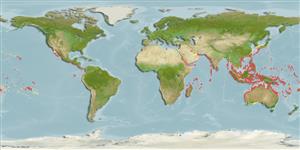Common names from other countries
Environment: milieu / climate zone / depth range / distribution range
Écologie
marin; saumâtre récifal; profondeur 0 - 20 m (Ref. 48637). Tropical
Indo-Pacific: East Africa to Samoa and the Hawaiian Islands.
Taille / Poids / Âge
Maturity: Lm ? range ? - ? cm
Max length : 7.5 cm TL mâle / non sexé; (Ref. 11344)
Description synthétique
Clés d'identification | Morphologie | Morphométrie
Épines dorsales (Total) : 7; Rayons mous dorsaux (Total) : 9; Épines anales: 1; Rayons mous anaux: 8. Brown with irregular spots; dorsal and caudal fins with bands in females, dusky in males; often with dark brown saddle below each of the dorsal fins (Ref. 2798); characterized further by having upper five pectoral rays with free tips and sixth ray partly free; three branches on upper four pectoral rays; rounded caudal fin; longitudinal scale series 37-38; predorsal scales 18-20, reaching or nearly reaching interorbital space; cheek and opercle without scales; presence of fleshy double flap from edge of cheek into notch at posterior end of upper lip; ctenoid body scales, becoming cycloid on abdomen, breast, base of pectoral fin and nape; depressed head, width greater than depth; depth of body 4.3-5.5 in SL (Ref. 90102).
Inhabits intertidal seaward reef flats (Ref. 37816, 48637). Also found in shallow reefs near shore (Ref. 90102).
Life cycle and mating behavior
Maturities | Reproduction | Spawnings | Egg(s) | Fecundities | Larves
Benthic spawner.
Randall, J.E. and M. Goren, 1993. A review of the gobioid fishes of the Maldives. Ichthyol. Bull. J.L.B. Smith Inst. Ichthyol. (58):1-37, 5 pls. (Ref. 9360)
Statut dans la liste rouge de l'IUCN (Ref. 130435)
CITES (Ref. 128078)
Not Evaluated
Menace pour l'homme
Harmless
Utilisations par l'homme
Outils
Articles particuliers
Télécharger en XML
Sources Internet
Estimates based on models
Preferred temperature (Ref.
115969): 24.2 - 29.3, mean 28.2 (based on 3609 cells).
Phylogenetic diversity index (Ref.
82804): PD
50 = 0.5000 [Uniqueness, from 0.5 = low to 2.0 = high].
Bayesian length-weight: a=0.01023 (0.00477 - 0.02194), b=3.02 (2.84 - 3.20), in cm Total Length, based on LWR estimates for this (Sub)family-body shape (Ref.
93245).
Niveau trophique (Ref.
69278): 3.4 ±0.5 se; based on size and trophs of closest relatives
Résilience (Ref.
120179): Haut, temps minimum de doublement de population inférieur à 15 mois (Preliminary K or Fecundity.).
Fishing Vulnerability (Ref.
59153): Low vulnerability (10 of 100).
